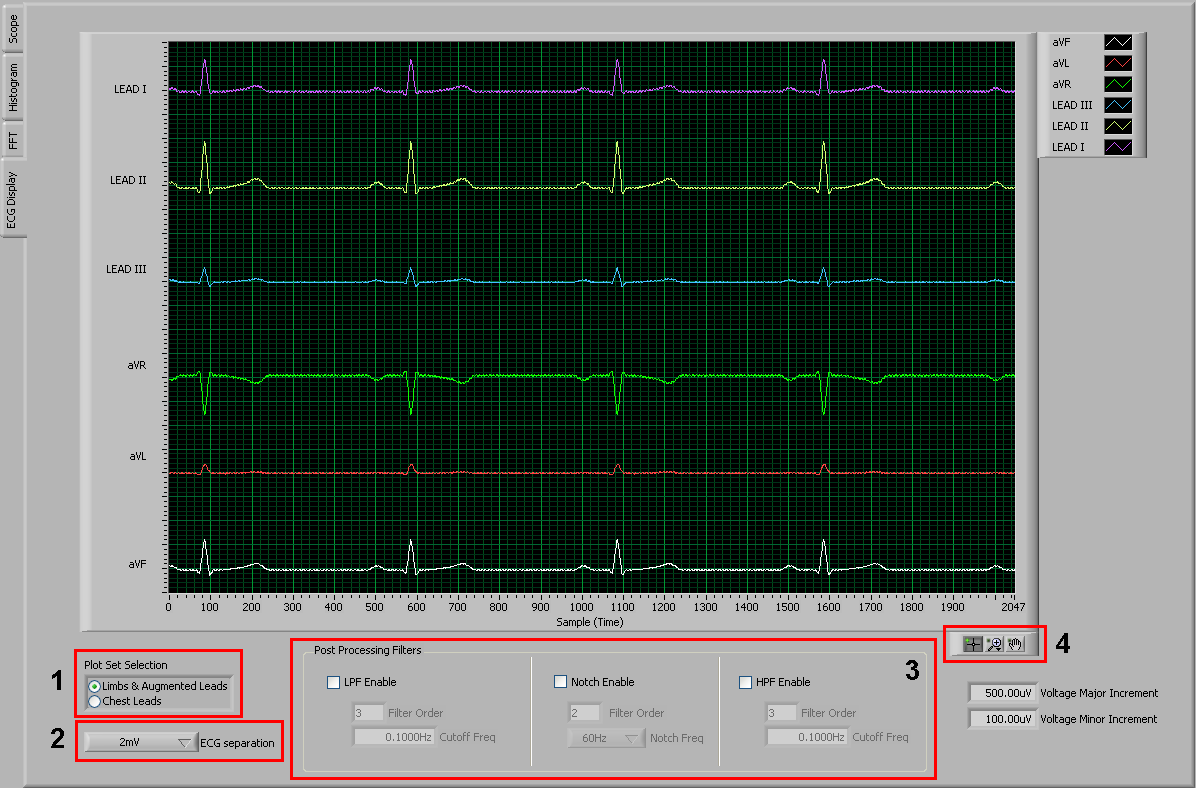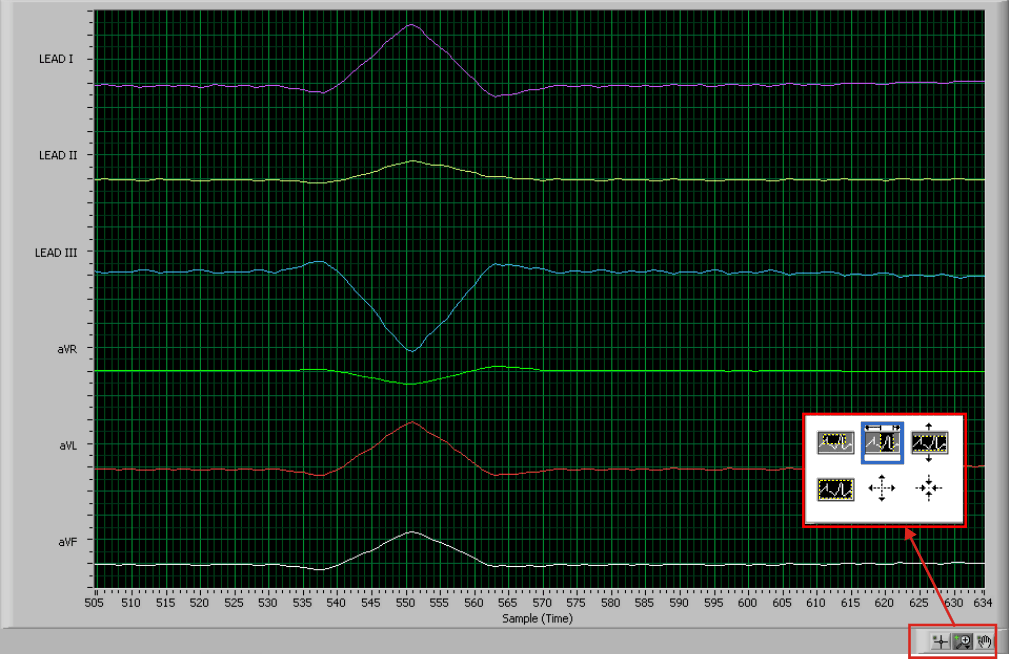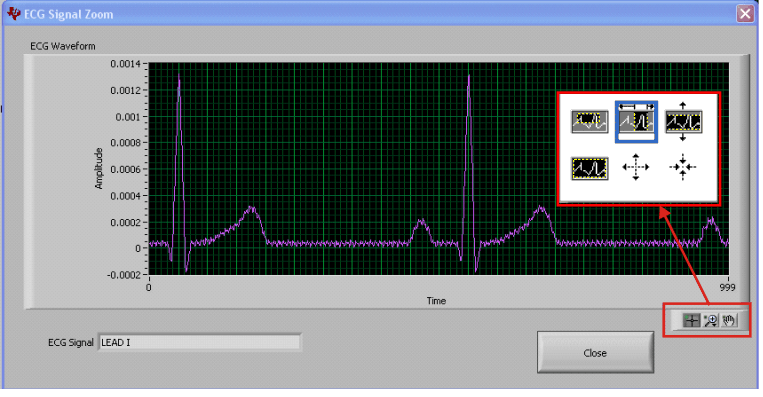SBAU171D May 2010 – January 2016 ADS1198 , ADS1298
-
ADS1298ECG-FE/ADS1198ECG-FE
- Trademarks
- 1 ADS1298ECG-FE/ADS1198ECG-FE Overview
- 2 Quick Start
- 3
Using the ADS1298ECG-FE Software
- 3.1 Application User Menu
- 3.2 Top-Level Application Controls
- 3.3 About Tab
- 3.4 ADC Register Tab
- 3.5 Analysis Tab
- 3.6 Save Tab
- 4 ADS1x98ECG-FE Input Signals
- 5 ADS1298ECG-FE/ADS1198ECG-FE Hardware Details
- ASchematics, BOM, Layout, and ECG Cable Details
- BExternal Optional Hardware
- CSoftware Installation
3.5.4 ECG Tab (Analysis)
This tool allows the user to examine the input signal according to the different lead configurations. For a detailed description of the lead configurations, see Table 2 in Section 4.6. Figure 27 shows Leads I-III and the Augmented Lead outputs with the input MUX configured in Normal Electrode mode. Figure 27 also shows numerical annotations 1 to 4, which highlight the different features of this tool. These features are described in detail in the following subsections.
 Figure 27. ECG Display Tab Showing LEAD I-III and Augmented Leads
Figure 27. ECG Display Tab Showing LEAD I-III and Augmented Leads 1 - Plot Set Selection Feature
The Plot Set Selection control allows the user to change the visual selection between:
- Limbs and Augmented Leads displays LEAD I, LEAD II, LEAD III, aVR, aVL, and AVF signals,
- Chest Leads displays V1 - V6 signals.
NOTE
For display that shows 6 leads combined, the ECG signals have any DC offset removed and a different offset added to the signal to display the signals as shown. To see the raw ECG data, you can select the individual signals as described below in the Zoom feature (box 4).
2 - ECG Separation Feature
The ECG separation control toggles the vertical distance between the input plots. This capability is useful when ECG signals are large and require more separation to avoid overlap, or to collapse the range between signals when the ECG signals are small.
3 - Post Processing Filters Feature
The Post Processing Filters Features controls provides a low-pass, a 50Hz/60Hz notch, and a high-pass digital filters for post-processing the data from the ADS1298. To activate each filter, the Enable checkbox should be checked. To disable the filter, the Enable checkbox should be unchecked. Any combination of the three digital filters can be used by enabling the respective filter.
The low-pass filter controls a digital low-pass filter, whose order and cutoff frequency are controlled using the Filter Order and Cutoff Freq controls in the low-pass filter part of the Post Processing Filters group (left side of the box).
The notch filter provides a 50Hz/60Hz notch filter, whose order and 50Hz/60Hz notch selection are controlled using the Filter Order and Notch Freq controls in the low-pass filter part of the Post Processing Filters group (center of the box).
The high-pass filter controls a digital high-pass filter, whose order and cutoff frequency are controlled using the Filter Order and Cutoff Freq controls in the high-pass filter part of the Post Processing Filters group (right side of the box).
NOTE
The digital filters are not part of the ADS1298. These are digital filters implemented in the UI to aid in the evaluation of the ADS1298ECG-FE.
4 - Zoom Feature
The zoom feature is available to allow the user to navigate and view all signals at the same time, as shown in Figure 28. This tool allows the user to zoom in/out on the horizontal or vertical axis and pan left or right while viewing all ECG signals simultaneously.
 Figure 28. ECG Signal Zoom Feature for Six Leads
Figure 28. ECG Signal Zoom Feature for Six Leads Additionally, each ECG signal can be zoomed individually by moving the mouse (which appears as a plus icon) over the lead of interest and clicking on it. A new window opens showing the raw ECG data as read from the ADS1298. This window provides controls in the lower right corner to zoom in/out or pan right/left to provide a more detailed inspection of the individual ECG signal.
 Figure 29. ECG Signal Zoom Feature for Lead 1
Figure 29. ECG Signal Zoom Feature for Lead 1